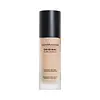bareMinerals Original Pure Serum Radiant Natural Liquid Foundation Mineral SPF 20 Versus Juice Beauty Phyto-Pigments Flawless Serum Foundation
What's inside
What's inside
 Key Ingredients
Key Ingredients

 Benefits
Benefits

 Concerns
Concerns

 Ingredients Side-by-side
Ingredients Side-by-side

Caprylic/Capric Triglyceride
MaskingCoconut Alkanes
EmollientMica
Cosmetic ColorantSilica
AbrasiveStearalkonium Hectorite
Gel FormingCoco-Caprylate/Caprate
EmollientGlycerin
HumectantLecithin
EmollientJojoba Esters
EmollientPropylene Carbonate
SolventPhenoxyethanol
PreservativeTocopheryl Acetate
AntioxidantButylene Glycol
HumectantWater
Skin ConditioningMagnesium Ascorbyl Phosphate
AntioxidantNymphaea Alba Flower Extract
Skin ConditioningSodium Hyaluronate
HumectantCI 77891
Cosmetic ColorantIron Oxides
Caprylic/Capric Triglyceride, Coconut Alkanes, Mica, Silica, Stearalkonium Hectorite, Coco-Caprylate/Caprate, Glycerin, Lecithin, Jojoba Esters, Propylene Carbonate, Phenoxyethanol, Tocopheryl Acetate, Butylene Glycol, Water, Magnesium Ascorbyl Phosphate, Nymphaea Alba Flower Extract, Sodium Hyaluronate, CI 77891, Iron Oxides
Aloe Barbadensis Leaf Juice
Skin ConditioningCarthamus Tinctorius Flower
MaskingGlycerin
HumectantCoconut Alkanes
EmollientPotassium Cetyl Phosphate
EmulsifyingSorbitan Sesquioleate
EmulsifyingGluconolactone
Skin ConditioningCetearyl Olivate
Silica
AbrasiveSorbitan Olivate
EmulsifyingCoco-Caprylate
EmollientSodium Benzoate
MaskingDecyl Glucoside
CleansingHydroxyethylcellulose
Emulsion StabilisingSodium Bicarbonate
AbrasiveCitrus Limon Leaf Cell Extract
Skin ConditioningHelianthus Annuus Seed Oil
EmollientVitis Vinifera
MaskingTetrahexyldecyl Ascorbate
AntioxidantTocopherol
AntioxidantArgania Spinosa Shell Powder
AbrasiveRosa Gallica Flower Powder
Skin ConditioningTitanium Dioxide
Cosmetic ColorantIron Oxides
Aloe Barbadensis Leaf Juice, Carthamus Tinctorius Flower, Glycerin, Coconut Alkanes, Potassium Cetyl Phosphate, Sorbitan Sesquioleate, Gluconolactone, Cetearyl Olivate, Silica, Sorbitan Olivate, Coco-Caprylate, Sodium Benzoate, Decyl Glucoside, Hydroxyethylcellulose, Sodium Bicarbonate, Citrus Limon Leaf Cell Extract, Helianthus Annuus Seed Oil, Vitis Vinifera, Tetrahexyldecyl Ascorbate, Tocopherol, Argania Spinosa Shell Powder, Rosa Gallica Flower Powder, Titanium Dioxide, Iron Oxides
Ingredients Explained
These ingredients are found in both products.
Ingredients higher up in an ingredient list are typically present in a larger amount.
Coconut Alkanes is created from the fatty-acids of coconut oil. It is volatile, meaning it evaporates from the skin.
This ingredient is an emollient and solvent. As an emollient, it helps keep skin soft and hydrated. Solvents help distribute and mix other ingredients. This ensures a more even consistency.
Coconut Alkanes may not be fungal-acne safe.
Learn more about Coconut AlkanesGlycerin is already naturally found in your skin. It helps moisturize and protect your skin.
A study from 2016 found glycerin to be more effective as a humectant than AHAs and hyaluronic acid.
As a humectant, it helps the skin stay hydrated by pulling moisture to your skin. The low molecular weight of glycerin allows it to pull moisture into the deeper layers of your skin.
Hydrated skin improves your skin barrier; Your skin barrier helps protect against irritants and bacteria.
Glycerin has also been found to have antimicrobial and antiviral properties. Due to these properties, glycerin is often used in wound and burn treatments.
In cosmetics, glycerin is usually derived from plants such as soybean or palm. However, it can also be sourced from animals, such as tallow or animal fat.
This ingredient is organic, colorless, odorless, and non-toxic.
Glycerin is the name for this ingredient in American English. British English uses Glycerol/Glycerine.
Learn more about GlycerinSilica, also known as silicon dioxide, is a naturally occurring mineral. It is used as a fine, spherical, and porous powder in cosmetics.
Though it has exfoliant properties, the function of silica varies depending on the product.
The unique structure of silica enhances the spreadability and adds smoothness, making it a great texture enhancer.
It is also used as an active carrier, emulsifier, and mattifier due to its ability to absorb excess oil.
In some products, tiny microneedles called spicules are made from silica or hydrolyzed sponge. When you rub them in, they lightly polish away dead skin layers and enhance the penetration of active ingredients.
Learn more about SilicaThis ingredient is a combination of red, black, and yellow iron oxide pigments. This combination of colors is usually found in foundation, because it results in a "skin" color.